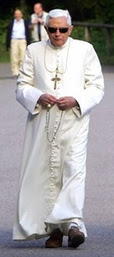"We're strictly B.C.P.... except for the Secret and the Canon and the Dominus vobiscum" – words from an amusing poem about Anglo-Catholic liturgical peculiarities, now more than amply instantiated in the new Ordinariate Mass.
There are various options which may be used: for instance, the Prayers at the Foot of the Altar (a noble English version of the Extraordinary Form prayers, including the Confiteor, and excluding only the Aufer a nobis – a pity, for it is one of the oldest of the preparatory prayers – and the Oramus te); the Offertory prayers in Form I (those of the Extraordinary Form, omitting only the psalm-verses recited during the censing the altar); the Roman Canon (including the modern wording of the words of consecration, and the Memorial Acclamation); and the Last Gospel. Using all these, and recalling also that the first Dominus vobiscum immediately precedes the Collect, that the text of the Embolism, or Libera nos, after the Lord's Prayer, is according to the EF version, and that the Domine non sum dignus is thrice repeated, the Ordinariate Mass looks very much like Mass according to the immemorial Roman Rite.
However, specifically Anglican aspects are also present, so it is not merely the traditional Latin Mass in English: Mass begins with the Collect for Purity; next, especially for the benefit of North American congregations, wherein use thereof is more common, the Decalogue or the Summary of the Law may be recited; the texts of the Kyrie, Gloria in excelsis, Credo, Sanctus, and Agnus Dei follow traditional Anglican renderings (with very minor adjustments); the various forms of the general intercessions derive from Anglican forms, such as the Prayer for All Conditions of Men (already present in the English translation of the modern Roman Divine Office, by some bizarre quirk, as part of the intercessions at Evening Prayer of Wednesday, Week 4 of the Psalter); after those intercessions comes the penitential act, comprising the Invitation, general Confession, non-sacramental Absolution and the Comfortable Words (all 1662, lightly edited); so too, the Sursum corda dialogue and the Prefaces, the introduction to the Lord's Prayer, "Christ our Passover" at the fraction (a quotation from 1 Corinthians, but whose role here ultimately derives from a longer combined formula in the 1549 BCP), the Prayer of Humble Access, the words of administration of the Body and Blood of Christ, the Prayer of Thanksgiving after Communion (with some minor modifications to safeguard Catholic doctrine), and "The Peace", the final blessing at Mass, all follow the Anglican forms.
Again, the modern Roman Rite is not shied away from: the Introit (Entrance Antiphon) requires neither versicle nor Gloria Patri; the readings are taken from the current Ordinary Form Roman Lectionary according to the Revised Standard Version; the Offertory may follow Form II, which is that of the modern Roman Missal, in suitably Cranmerian language; on ferias, the modern Eucharistic Prayer II, put into hieratic English, may be used (just as it is by far the most common Eucharistic Prayer in everyday use); as noted above, the Memorial Acclamation follows the Consecration; and the dismissal at Mass may follow the modern variety of forms, such as Ite in pace.
I am surprised at myself to say it – I had thought that the most Anglican form possible would be theoretically preferable – but this new form of Mass contains treasures new and old, and shows forth to much advantage the spoils of the Egyptians "through the Red Sea brought at last", as of old God advised Moses to have the Israelites bring out with them at the Exodus.
Most notably, the way lies open for what the Abbot of Le Barroux desired years ago, at the last revision of the latest edition of the Roman Missal: the insertion of the ordinary of the Extraordinary Form as an option in the Ordinary Form Mass – if all priests were able, prudently and wisely, to choose for the advantage of devotion to begin Mass with the prayers at the foot of the altar, to use the older offertory prayers, to use the older embolism, and to end with the Last Gospel, then the gulf between the older and newer forms of Mass would be greatly narrowed, and such cross-fertilization would be a real enrichment of precisely those aspects of Mass – the sacrificial, the cultic – that have been impoverished.
Thanks and praise are due, under God, to the wise counsel of those tasked with drawing together these threads to help weave rich adornments for the sacred mysteries of Christ our Priest, which are ever to be celebrated with dignity and love.
I see that Gippsland Ordinariate News has linked to this post of mine; I hope my comments may be of some slight interest. My aim has always been to encourage and support the great project of Anglicanorum cœtibus, and that includes what Benedict XVI referred to therein as the sharing of the precious gifts of the Anglican Patrimony with the wider Church – which extends to the re-propagation of treasures of devotion left aside for the most part within the modern Roman Rite, but providentially maintained by Anglo-Catholics and now brought back with them to full union with the Holy See.
******
I see that Gippsland Ordinariate News has linked to this post of mine; I hope my comments may be of some slight interest. My aim has always been to encourage and support the great project of Anglicanorum cœtibus, and that includes what Benedict XVI referred to therein as the sharing of the precious gifts of the Anglican Patrimony with the wider Church – which extends to the re-propagation of treasures of devotion left aside for the most part within the modern Roman Rite, but providentially maintained by Anglo-Catholics and now brought back with them to full union with the Holy See.








No comments:
Post a Comment